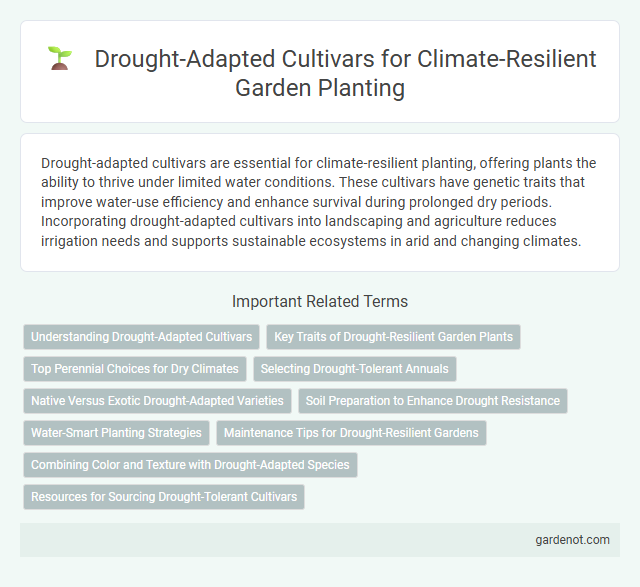Drought-adapted cultivars are essential for climate-resilient planting, offering plants the ability to thrive under limited water conditions. These cultivars have genetic traits that improve water-use efficiency and enhance survival during prolonged dry periods. Incorporating drought-adapted cultivars into landscaping and agriculture reduces irrigation needs and supports sustainable ecosystems in arid and changing climates.
Understanding Drought-Adapted Cultivars
Drought-adapted cultivars possess genetic traits that enhance water-use efficiency and improve survival under limited moisture conditions. These cultivars often feature deep root systems, reduced leaf area, and stomatal regulation mechanisms to minimize water loss. Understanding the physiological and genetic basis of drought tolerance enables the development of resilient crops tailored for climate change impacts.
Key Traits of Drought-Resilient Garden Plants
Drought-adapted cultivars possess key traits such as deep root systems, which enhance water uptake and improve survival during prolonged dry periods. These plants exhibit efficient stomatal regulation to minimize water loss while maintaining photosynthesis. Thick, waxy leaf coatings and reduced leaf surface area further contribute to their resilience by reducing evaporation and conserving moisture.
Top Perennial Choices for Dry Climates
Top perennial choices for dry climates include drought-adapted cultivars such as lavender, agave, and yucca, which possess deep root systems and efficient water-use traits. These plants enhance soil stabilization and maintain vegetative cover during prolonged dry spells, contributing to climate resilience. Selecting cultivars with proven tolerance to low moisture conditions optimizes landscape sustainability and reduces irrigation demands.
Selecting Drought-Tolerant Annuals
Selecting drought-tolerant annuals for climate-resilient planting enhances water efficiency by utilizing cultivars with deep root systems and reduced transpiration rates. Species such as millet, sorghum, and tepary beans demonstrate superior survival and yield under low-moisture conditions due to their genetic adaptations to arid environments. Incorporating these cultivars into agricultural systems supports sustainable crop production amidst increasing drought frequency and severity.
Native Versus Exotic Drought-Adapted Varieties
Drought-adapted cultivars play a crucial role in climate-resilient planting by enhancing crop survival under water-scarce conditions. Native drought-adapted varieties often exhibit superior resilience due to their long-term evolution within local ecosystems, offering traits like deep root systems and efficient water use. In contrast, exotic drought-adapted cultivars may introduce advantageous genetic diversity but sometimes struggle to thrive without local adaptation, making the integration of native varieties preferable for sustainable agricultural practices.
Soil Preparation to Enhance Drought Resistance
Drought-adapted cultivars thrive when soil preparation prioritizes moisture retention and aeration, involving deep tillage and organic matter incorporation to improve water-holding capacity. Applying mulch and utilizing contour plowing significantly reduce soil evaporation and runoff, enhancing drought resilience. Proper soil preparation fosters root penetration and nutrient uptake, critical for the successful establishment of drought-tolerant plants.
Water-Smart Planting Strategies
Drought-adapted cultivars enhance climate-resilient planting by requiring less water and thriving under limited moisture conditions, making them essential for water-smart planting strategies. These cultivars improve crop yield stability during prolonged dry spells by optimizing water use efficiency and reducing irrigation needs. Integrating drought-tolerant varieties with soil moisture conservation techniques promotes sustainable agriculture in arid and semi-arid regions.
Maintenance Tips for Drought-Resilient Gardens
Drought-adapted cultivars require minimal watering once established, promoting efficient water use and enhancing garden resilience during dry spells. Mulching around plants conserves soil moisture, suppresses weeds, and stabilizes root temperatures, critical for drought conditions. Regularly inspecting soil moisture levels and pruning dead or damaged foliage help maintain plant health and optimize water uptake in drought-resilient gardens.
Combining Color and Texture with Drought-Adapted Species
Drought-adapted cultivars enhance climate resilience by thriving in low-water conditions while maintaining vibrant color and appealing texture in landscape design. Selecting species such as succulents, ornamental grasses, and native shrubs combines aesthetic diversity with water efficiency. Integrating these cultivars supports sustainable planting strategies that reduce irrigation needs and improve ecosystem stability.
Resources for Sourcing Drought-Tolerant Cultivars
Farmers and gardeners can source drought-tolerant cultivars from specialized seed banks and agricultural research centers that focus on climate-resilient planting. Institutions such as the International Crops Research Institute for the Semi-Arid Tropics (ICRISAT) and the U.S. National Plant Germplasm System provide access to genetic resources optimized for low-water environments. Online platforms like the Seed Savers Exchange also offer varieties bred specifically for drought resistance, supporting sustainable agriculture in arid regions.
Drought-adapted cultivar Infographic

 gardenot.com
gardenot.com